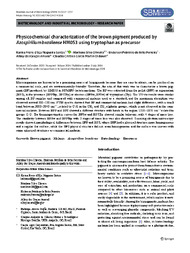Physicochemical characterization of the brown pigment produced by Azospirillum brasilense HM053 using tryptophan as precursor.
Physicochemical characterization of the brown pigment produced by Azospirillum brasilense HM053 using tryptophan as precursor.
Author(s): SANTOS, K. F. D'E. N.; OLIVEIRA, M. S.; FERREIRA, E. P. de B.; AMARAL, A. das G.; MARTIN-DIDONET, C. C. G.
Summary: Microorganisms are known to be a promising source of biopigments because they are easy to obtain, can be produced on a commercial scale, and are environmentally friendly. Therefore, the aim of this work was to characterize a brown pigment (BP) produced by HM053 in NFbHPN-lactate medium. The BP was extracted from the pellet (BPP) or supernatant (BPS), in the presence (BPPTrp, BPSTrp) or absence (BPPw, BPSw) of tryptophan (Trp). The UV-vis results were similar among all BP samples and compared with commercial melanin used as a standard, and the maximum absorption was observed around 200–220 nm. FTIR spectra showed that BP and commercial melanin had slight differences, with a small band between 3000–2840 cm? 1, related to C-H in the CH2 and CH3 aliphatic groups, which is not observed in the commercial melanin. Between BPP and BPS showed a different structure with bands in the region 1230–1070 cm? 1 related to groups C-O. The thermogravimetric curves for BPSw and BPSTrp showed similar behavior, with 4 stages of mass loss. The similarity between BPPw and BPPTrp with 2 stages of mass loss was also observed. Scanning electron microscopy results showed morphological differences between BPP and BPS, where BPP had a physical structure more homogeneous and a regular flat surface, while the BPS physical structure did not seem homogeneous and the surface was uneven with some spherical structures as commercial melanin.
Publication year: 2024
Types of publication: Journal article
Unit: Embrapa Rice & Beans
Observation
Some of Embrapa's publications are published as ePub files. To read them, use or download one of the following free software options to your computer or mobile device. Android: Google Play Books; IOS: iBooks; Windows and Linux: Calibre.
Access other publications
Access the Agricultural Research Database (BDPA) to consult Embrapa's full library collection and records.
Visit Embrapa Bookstore to purchase books and other publications sold by Embrapa.

